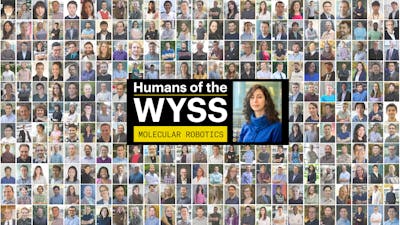
The Humans of the Wyss series features members of the Wyss community discussing how they think about their work, the influences that help shape them as scientists, and their collaborations at the Wyss Institute and beyond.
In this installment of our Molecular Robotics Edition, we talk to Postdoctoral Fellow Sinem Saka, Ph.D. about her work inventing DNA-based tools and methods and how she envisions her research impacting the world.
What drives you?
I really enjoy the idea of creating a new entity or a combination that did not exist before, and applying it to solve a problem. In my previous research, I relied heavily on imaging techniques, and experienced the technical challenges, such as resolution, sensitivity, specificity and multiplexing limitations first-hand. Now using Molecular Robotics, I am trying to tackle each of these challenges by inventing DNA-based tools and methods.
You’re working on DNA-based imaging methods, tell us more.
Leveraging our knowledge of DNA-DNA interactions, we are developing new tools and methods that feature nanoscale programmability. We are primarily using these tools to improve the resolution, multiplexing capability and sensitivity of optical imaging. Currently physicians have to diagnose diseases or recommend a treatment based on very limited patient-specific information, because the number of biomarkers that they can detect in a single sample, for example a tissue biopsy, is very restricted. These limitations also apply to research and development settings, and cause significant gaps in understanding diseases and delay implementing new therapies. We are trying to break these barriers to achieve higher information content.
I really enjoy the idea of creating a new entity or a combination that did not exist before, and applying it to solve a problem.
Share with us some of the challenges you’re facing.
We are lucky to live in an age where new frontiers are opening daily. Embedded in this stimulating environment and intellectual diversity, innovative ideas come up almost every day, but it is not feasible to follow them up all. It becomes a big challenge to manage resources and stay focused yet open to innovation. Similarly, in our experiments we are dealing with parameter spaces too large to handle, hence we need to identify the most critical factors early on and prioritize.
So, how do you envision your work impacting the world?
The general trend in medicine is towards less invasive procedures, such as taking smaller biopsies and being able to learn more from that smaller sample. With our tools, we aim to enable researchers and clinicians to extract information at a higher content and better quality from such scarce samples.
